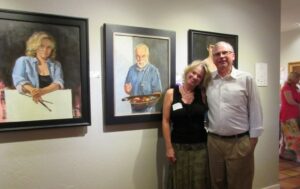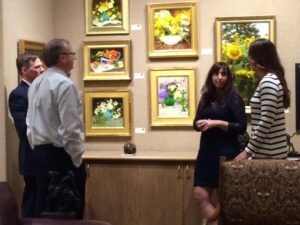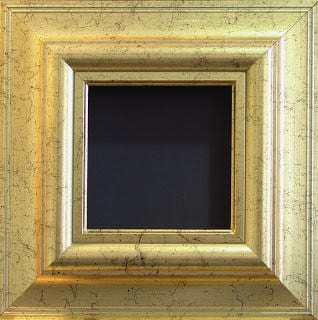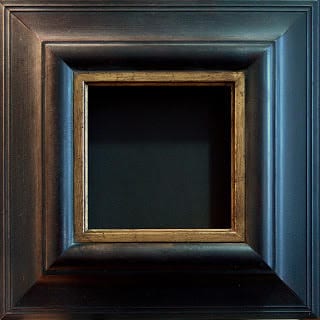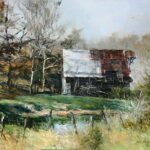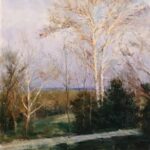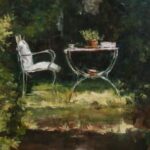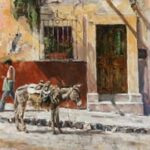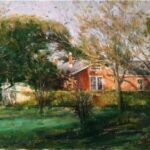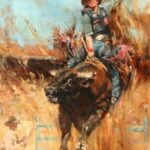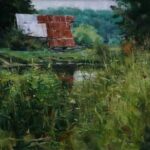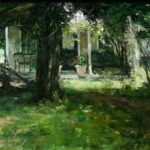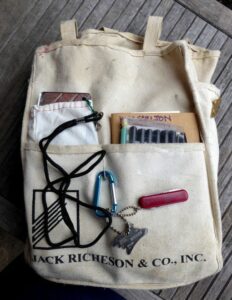
It’s not that I’m unimpressed by raindrops on roses or whiskers on kittens. It’s just that my favorite things are the things that help me simplify and strengthen my paintings. I have a handy bag that carries a few of my favorite things, stowed together with my painting gear in my backpack. In the back pocket of it are my idea-catchers and planning tools, kept handy for sketching out inspiration before I break out and set up my painting gear. In the right pocket, you can see my moleskine sketchbook and drawing tools. In the left pocket is my super-awesome MVP.
Developed by Peggi Kroll Roberts, the MVP is a tool that consists of a Mirror, a Value viewer, and a painting Planner. They come in a protective bag and are attached to a lanyard, which allows you to have the MVP around your neck while you are out in the field.
Presented in a 9×12 format, the planner is outlined in black to help you see the subject in isolation. The grid allows you to plan strategic “sweet spots” in a balanced, well-composed painting. It is helpful to have the same ratio (9×12) plotted out on page or canvas for ease of transfer. I travel with a variety of canvases, but normally use 8×10 or 9×12 as they are easy sizes for scaling up in the studio.
The way I normally use my planner is sandwiched together with the value viewer. This allows me to very quickly see likely candidates for a painting, as these two work as a team to show the simplicity and strength of good light and shadow patterns.
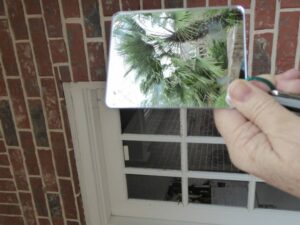
The mirror is a good tool to affirm a composition choice and will also come in very handy later, when the painting is in progress. Looking at the subject upside-down in the mirror or viewing the painting and the subject together in the mirror will miraculously show the painter where weaknesses are. Also—and this is extra—it can be used to signal the search helicopter if you get lost, and let you check to make sure you look fabulous before they come to your rescue! I need to remember to tell Peggi that she should include that in the write-up (note to self).
You will see, when you begin viewing the world through the dark red Plexiglas, how easy it is to create your perfect notan (portrait and figurative painters may want to try a green viewer, but the red viewer is perfect for the landscape painter).
This is a scene from the east coast of Florida, made into an abstract design just by applying the red filter!
The next step will be to plan out a painting, either directly on canvas or—in my case here—in a sketchbook.
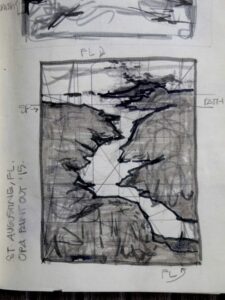 The MVP makes capturing the essence of a rapidly-changing scene much easier by literally framing and filtering it down to a wonderful design. I spent about an hour on the whole plan, including the strategy sketch and the transfer to my canvas. It’s amazing how much more smoothly the painting process goes when you have confidence in the plan and structure that underlies it. Having the right tools to simplify our job will go a long way toward the creation of stronger paintings.
The MVP makes capturing the essence of a rapidly-changing scene much easier by literally framing and filtering it down to a wonderful design. I spent about an hour on the whole plan, including the strategy sketch and the transfer to my canvas. It’s amazing how much more smoothly the painting process goes when you have confidence in the plan and structure that underlies it. Having the right tools to simplify our job will go a long way toward the creation of stronger paintings.If you are interested in learning more about the MVP and the other great tools that Ray and Peggi Kroll Roberts have created for artists, visit them at www.krollroberts.com and click on the Shop tab. Work smarter, not harder, so you can just paint your joy!





 I paint with both water-mixable oils and traditional oils, and I get a wide variety of responses when people discover this. Everything from rude negativity (“what crap is that?”) to nods from those in the know (“I use them too, aren’t they great!”). It’s rather funny, as most art supplies don’t have groupies or naysayers like this… The lovers and the haters of water-mixables.
I paint with both water-mixable oils and traditional oils, and I get a wide variety of responses when people discover this. Everything from rude negativity (“what crap is that?”) to nods from those in the know (“I use them too, aren’t they great!”). It’s rather funny, as most art supplies don’t have groupies or naysayers like this… The lovers and the haters of water-mixables.
 Faster Dry Time. Water-mixables dry in about half the drying time of traditional oils. The paints actually have two dry times. For thin watery mixes (like a watercolor wash or canvas tone) the water evaporates rapidly and is mostly dry to the light touch in 5-10 minutes. You can still re-wet areas to wipe out or re-mix. At this stage it is possible to start more direct painting, or layering with thicker strokes. To let a thin tone or grisalle layer fully dry (via oxidation) wait at least until the next day. The thicker the paint application (the less water used), the more your dry times will increase. Paint that contains a lot of oil already such as Cadmiums can take longer to dry.
Faster Dry Time. Water-mixables dry in about half the drying time of traditional oils. The paints actually have two dry times. For thin watery mixes (like a watercolor wash or canvas tone) the water evaporates rapidly and is mostly dry to the light touch in 5-10 minutes. You can still re-wet areas to wipe out or re-mix. At this stage it is possible to start more direct painting, or layering with thicker strokes. To let a thin tone or grisalle layer fully dry (via oxidation) wait at least until the next day. The thicker the paint application (the less water used), the more your dry times will increase. Paint that contains a lot of oil already such as Cadmiums can take longer to dry.
 Brand Comparison/Reviews of Water-Mixable Paints:
Brand Comparison/Reviews of Water-Mixable Paints:
